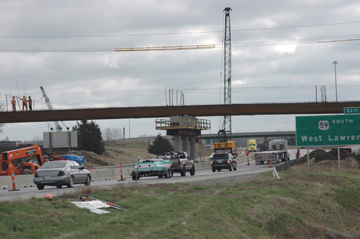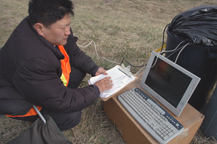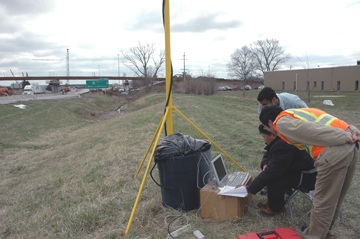Profs Harness Technology to Streamline Construction

A project under way north of Lawrence is all about saving time and money. Yong Bai, assistant professor of civil, environmental and architectural engineering at the University of Kansas, has launched a research project that aims to improve productivity and cost efficiency of highway construction projects through on-site, real-time monitoring.
Bai and Jun "Luke" Huan, assistant professor of electrical engineering and computer science, are creating a multifaceted system that uses video cameras, image processing, data mining as well as real-time and wireless technologies to monitor, evaluate and communicate work zone construction activities.

“If successful we can use this technology to enhance rapid bridge infrastructure replacement,” said Bai, who specializes in construction management.
Highway and bridge construction work zones are a necessary inconvenience for motorists and taxpayers. According to the U.S. Federal Highway Administration, Kansas ranks fourth in the nation in total roadway miles and third in the nation for number of bridges. An information tool of this nature would allow construction project managers to ensure work is completed efficiently and safely, take pre-emptive action to avoid delays and possibly even monitor multiple work sites from a single, remote location.
The system is being tested by Bai and his research team on a bridge replacement project over Interstate 70 near the West Lawrence interchange. Graduate students Seong Hoon Kim and Yue Li are capturing video and still images of the work zone and developing the communications systems necessary to send those images in real time to an off-site project manager. At this time the team is simply collecting the images for further analysis.

A major component of the project is the image analysis required to better understand the human poses of construction operations — the specific body movements involved in efficiently completing a project. Huan and computer science graduate student Abhinav Peddi are producing this aspect of the project. There are two parts to this challenge, Huan said.
“First, we use image analysis to understand the human poses,” Huan said. Through data mining, the researchers will pull and categorize important bits of information from each frame of video. The second part is to connect human poses to productivity. This step requires Huan and Peddi to develop algorithms that accurately predict efficiency and productivity at the site.
Ideally the research team would be able to set up three video cameras in a triangle pattern to get a complete view of the construction site and all workers, Peddi said. The image processing will be able to distinguish between fixed objects — trees, signs, pillars, utility poles and the like — construction workers and traffic on open lanes.

The KU researchers expect they will be able to identify each worker individually and track their movements, productivity and safety patterns. Ultimately, the research team is striving to be able to compute the overall productivity of workers as a team and as individuals through image analysis. A remotely located project manager would see the live video streams and statistics about the crew’s overall productivity and have ready access to more in-depth information. Project managers might even be able to tell if workers are using correct postures to safely complete a task.
The goal isn’t to penalize workers, but instead to ensure that construction projects finish on time and finish safely. These simple objectives will save taxpayer dollars, as well as allow traffic flow to return to normal as soon as possible. Project managers could even use the system to ensure equipment and materials arrive on schedule to avoid work slowdowns and identify whether workers need additional training to improve efficiency.
The project is funded through KU’s Transportation Research Institute, the Kansas Department of Transportation and the Federal Highway Administration and through two grants from the National Science Foundation.